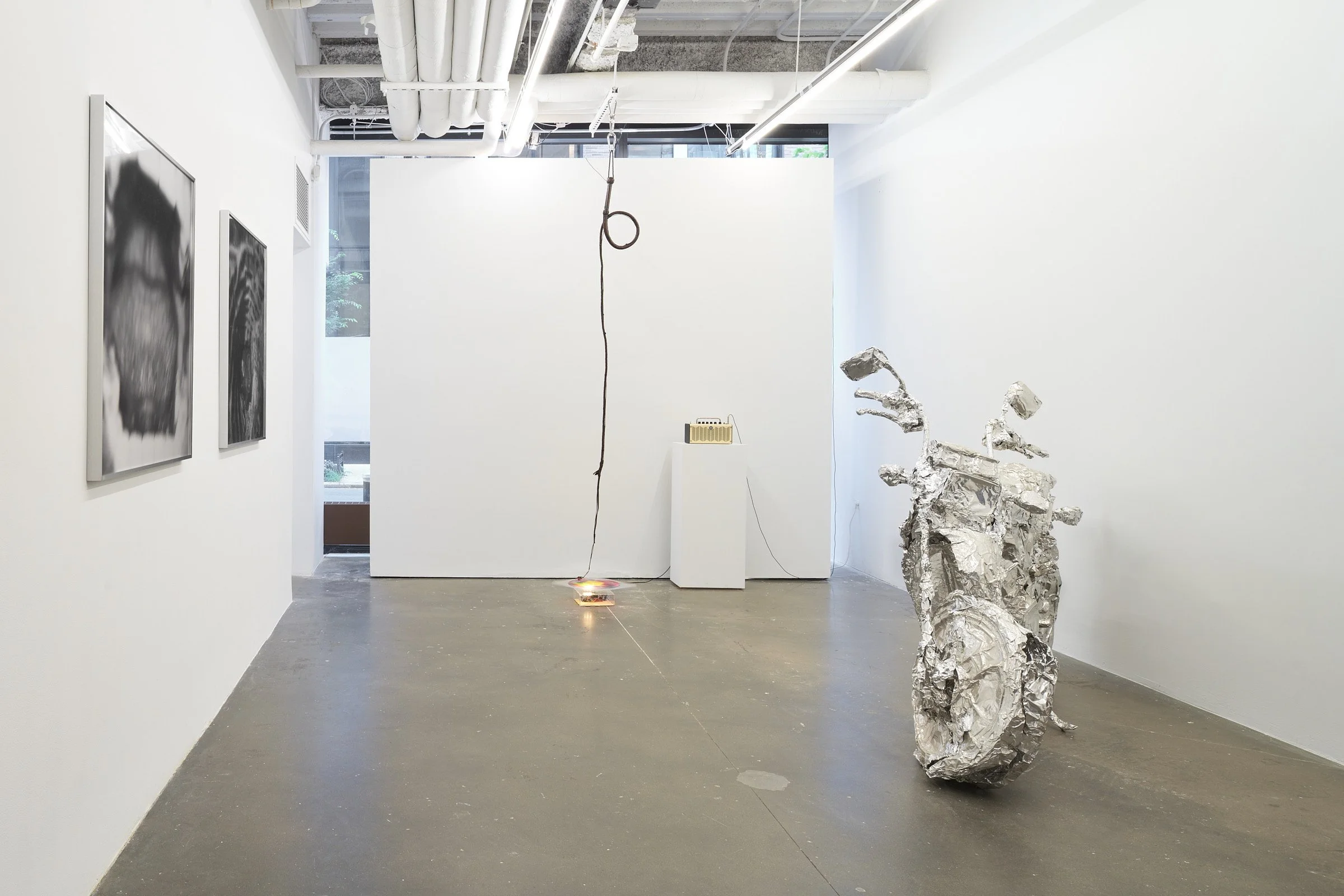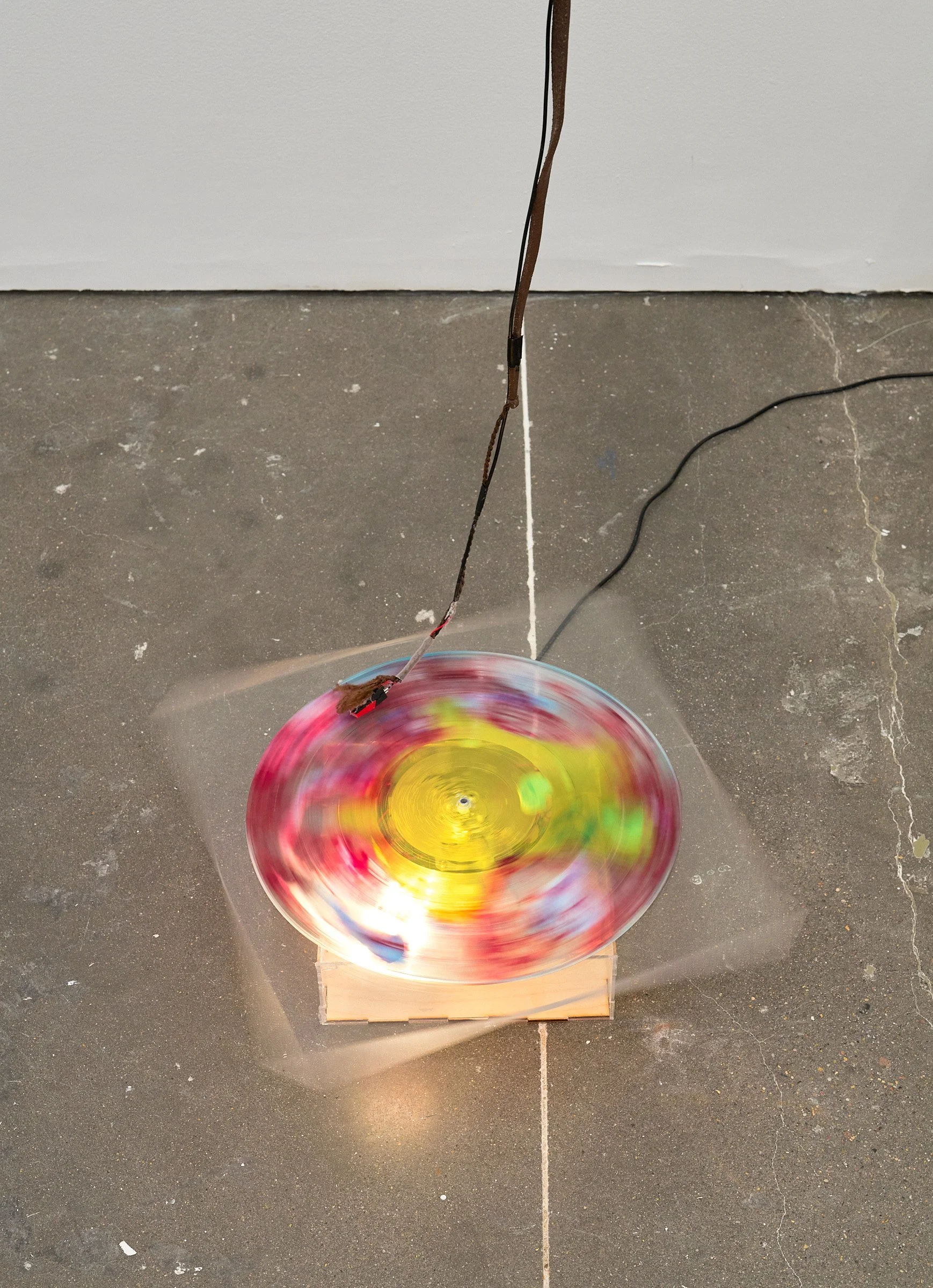Drifting without Handlebars
Below Grand is not your average Lower Manhattan gallery. These days, the gallery—if one can call it that—is located in three and a half different spaces, each exhibition space fostering a specific vibe. The showroom at 53 Orchard St feels like an emerging artist gallery. The storefront that opens to the street at 52 Allen dissolves the boundary between art viewing and street life, with pedestrian noise bleeding through the open doors. The small room located inside FY Trading Corp, a restaurant supply store connecting Allen and Orchard streets, functions as a kind of speakeasy gallery. And the space at 88 Essex St, inside Essex Market, appears as the more traditional blue-chip gallery setting—there, wine was offered at the opening—whereas at 52 Allen, we enjoyed cans of PBRs. This fragmented geography across a mere 0.3 square mile grid in Lower Manhattan becomes integral to understanding the exhibition’s central proposition: that meaning emerges not from fixed positions, but from movement between them.
This configuration uniquely positions Below Grand as an ideal venue for a group show such as its current No Handlebars, allowing each space to interrogate discrete yet related themes. Moreover, Below Grand’s architecture captures how the tension between cultural production and commercial necessity isn’t theoretical, but spatial, literally built into the viewing experience. As one attendee at the opening aptly described: “they really make use of every inch they got.”
Influenced by Arthur Rimbaud’s 1871 poem The Drunken Boat as their model for a poetics of exploration, the team of Below Grand “nominated artists who [they] thought represented something of great depth within each of [their] disciplines.” The team then invited the selected artists to repeat the process and “nominate someone they had deep respect for.” No Handlebars is the result of bringing together these artists.
This experiment in recursivity results in a compelling mosaic of works. At the storefront, Aric Grauke’s Smoke Break (2025), featuring veiny electronic wires wrapped around a cigarette like a dying hand, is paired with Timur Si-Qin’s photorealistic print of foliage, Untitled (Rhododendron, przewalskii, Yading) (2025). Juxtaposed, the pieces provide a meditation on the tension and interplay between representations of organic and inorganic matter—or life and death, if you will.
At 53 Orchard St., Apichaya Wanthiang’s floor piece, shoo evil, evil shoo / hum low, as low as you can go / sway, s-w-a-y, stop don't tear, pull or topple / caress, caress, ssshhhhh! (2025), into which viewers kept bumping and needed to awkwardly reassemble the offshoot pieces, sits alongside Peggy Chiang’s metal sculpture, WITHOUT BREAK WITH ALL POWER (2024), featuring bent spoons affixed to an aluminum cast. Both works challenge conventional relationships between viewer, object, and space.
The hidden room at the restaurant supply store concerns itself with the limits of human-made artificiality (or artificiality made human), featuring Karyn Nakamura’s video-art experiment with artificial image generation technology, Perfect Syntax (2024), alongside Lucy Kim’s biological screen print, Jade Grapes (10/30/22 Printing) #1 (2022), employs melanin produced by genetically modified E. coli cells on paper.
Meanwhile, the curation of works at 88 Essex contemplates the relationship between interiority and exteriority, with Jude Tallichet’s motorcycle exoskeleton made from aluminum foil, Ghost Bike Fabricated and pressed (2016), Nikita Gale’s x-ray-like prints of a mouth and a sarcophagus (or another internal organ), NOSEBLEED 12 (2024) and NOSEBLEED 14 (2024), and Victoria Shen’s rotating, customized vinyl played by a needle connected to a whip, One Thousand Cuts (2024).
The liberation of curation from a singular thematics is a sophisticated, intentional gesture. As its title suggests, the binding thread of No Handlebars is a dedication to drifting—a logic that goes against and beyond restrictive labels and boundaries of experience imposed by Enlightenment/Western/colonial modes of thinking. Opening a space for “feeling without processing,” as the press release proclaims, the exhibition invites viewers to let go, even if momentarily, of the auxiliary structures organizing our lives—our handlebars.
Nonetheless, the curators did not entirely forgo material considerations as a unifying force, or more precisely, the lack thereof. Instead of complete absorption in a plurality of references, No Handlebars converges at its elemental level. In other words, even to drift, one requires a raft: some common ground. In No Handlebars, it is air. Air functions throughout as both medium and metaphor—the condition that enables movement while marking the spaces between things. Shen’s rotating vinyl played by a whip-connected needle fills gallery space with sound that exists only in motion. Gale’s x-ray-like prints reveal internal cavities, the hollow spaces within bodies and objects. Even Wanthiang’s floor piece creates pockets of negative space that viewers must navigate around and through.
This staging of air becomes most evident in Tallichet’s work, a sculpture of a motorcycle rendered in utmost detail, down to its brand name, reveals itself to be made entirely of aluminum foil wrapped around empty space. What appears solid dissolves upon closer inspection into negative space: holes in the foil reveal the absence that hides underneath it. There is no motorcycle; or rather, the motorcycle that should be present is one made of air.
The exhibition’s attention to air and negative space reflects a curatorial intelligence that understands how meaning moves—not through fixed positions, but through the spaces between them. The exhibition succeeds not by abandoning structure entirely but by creating new kinds of frameworks, ones flexible enough to accommodate drift while substantial enough to sustain genuine artistic investigation.
In this way, No Handlebars achieves something rare: an exhibition that embodies its conceptual framework rather than simply illustrating it. By staging encounters with air, absence, and the spaces between things, it creates conditions for the kind of open attention its title promises. The handlebars remain available for those who need them, but for a moment, the exhibition makes letting go feel not just possible, but necessary.
No Handlebars is on view at Below Grand from July 12 through August 16, 2025.






